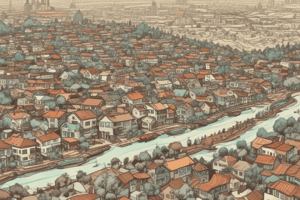Podcast
Questions and Answers
Which of the following best explains why cities typically have a higher population density compared to rural areas?
Which of the following best explains why cities typically have a higher population density compared to rural areas?
- Rural areas have better infrastructure, discouraging population concentration.
- Cities offer more job opportunities and attract a larger number of residents to a smaller area. (correct)
- Rural areas have a higher birth rate than cities.
- Cities have more land area available for people to live on.
A country with a minimum population size requirement of 500 people to be considered a city will likely have more designated cities than a country with a requirement of 10,000.
A country with a minimum population size requirement of 500 people to be considered a city will likely have more designated cities than a country with a requirement of 10,000.
True (A)
Explain how a country's specific social or economic conditions might influence its decision regarding the minimum population size for a location to be classified as a city.
Explain how a country's specific social or economic conditions might influence its decision regarding the minimum population size for a location to be classified as a city.
A country's decision on minimum population size for city classification can reflect its urbanization level and economic structure. More industrialized or densely populated countries might set higher thresholds, while developing nations may use lower limits to promote regional development or recognize urbanizing areas.
The formula for calculating population density is: Population Density = Number of people / ______.
The formula for calculating population density is: Population Density = Number of people / ______.
Match the following scenarios with their impact on population density, assuming all other factors remain constant:
Match the following scenarios with their impact on population density, assuming all other factors remain constant:
Flashcards
City (Population)
City (Population)
A location with a notably large number of residents compared to other areas in the same country.
Minimum Population Size
Minimum Population Size
A guideline some countries use to determine city status.
Population Density
Population Density
The number of people living in a specific unit of land area.
Population Density Formula
Population Density Formula
Signup and view all the flashcards
Town
Town
Signup and view all the flashcards
Study Notes
- Cities have many people living and working in them, resulting in a large population size compared to other locations.
- Various countries use different guidelines to identify their cities.
- Minimum population size is one guideline.
- Mexico City, Mexico has a population of 24.1 million.
- São Paulo, Brazil has a population of 23.8 million.
- An urban area with a population of 500 is considered a city in some countries.
- Other countries require a population of 2,000 to be considered a city.
- Some countries require a population size of 10,000 for an urban area to be considered a city.
High Population Density
- Population density measures the number of people living in a unit of land area.
- Cities typically have a high population density compared to other areas.
- Shanghai, China, has a population density of about 2,100 people per square kilometer.
- Population density is calculated by dividing the number of people living in an area by the land area.
Geo-Fact
- The term "town" can refer to an urban area.
- It usually refers to a smaller urban area than a city.
Studying That Suits You
Use AI to generate personalized quizzes and flashcards to suit your learning preferences.
Description
Explore city characteristics, focusing on population size and density. Compare population guidelines across countries, and examine population densities with examples like Shanghai. Learn the geo-facts.




